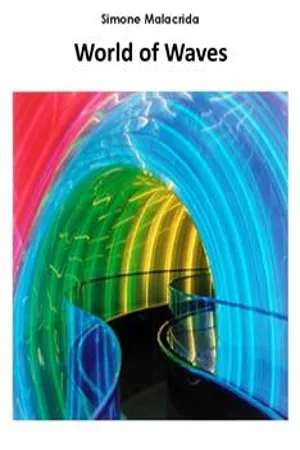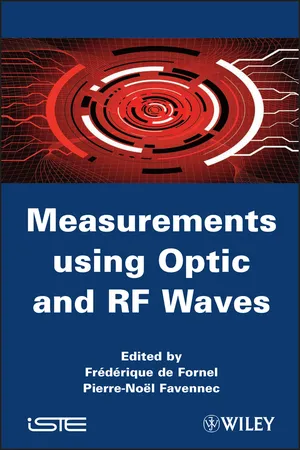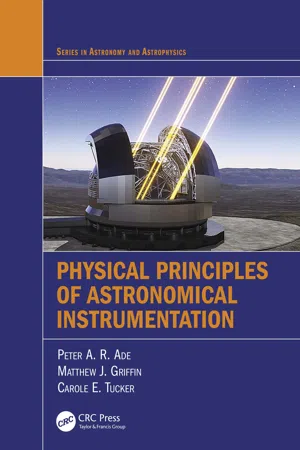Physics
Electromagnetic Sources
Electromagnetic sources are objects or systems that generate electromagnetic fields. These sources can include electric charges in motion, such as electrons flowing in a wire, or magnetic materials like permanent magnets. Electromagnetic sources are fundamental to the study of electromagnetism and play a crucial role in various technological applications, including generators, motors, and antennas.
Written by Perlego with AI-assistance
Related key terms
Related key terms
1 of 4
Related key terms
1 of 3
5 Key excerpts on "Electromagnetic Sources"
- eBook - ePub
- Simome Malacrida(Author)
- 2022(Publication Date)
- Simone Malacrida(Publisher)
THE SOURCES OF ELECTROMAGNETIC WAVES
On the other hand, one of the main questions involving electromagnetic waves has been concealed: what generates such a wave? Put another way, what are the sources of electromagnetic waves?I n the previous chapter, the main characteristics of electromagnetic waves were analyzed and an "energy" classification of these waves was defined using a general convention such as the electromagnetic spectrum. An attempt has also been made to provide a historical framework regarding the development of science and technology in relation to the various epochs and places where scientists have developed their theories and applications.The need for a source for electromagnetic waves is immediately clear if we think of river sources: just as a watercourse cannot exist if it does not have one or more sources, electromagnetic waves also do not exist by themselves, but need something to generate them. As we have seen, electromagnetic waves originate from the presence and variation in space and time of electrical or magnetic phenomena or even both; therefore, an electromagnetic wave source will have these characteristics.In this chapter we will see how sources of electromagnetic waves have different natures and how man has artificially created some of these sources based on the discoveries described in the first chapter. During the description, as done previously, we will also think about the historical and social context in which scientists put their discoveries into practice.–––––––– Natural sources of electromagnetic waves
–––––––– I - eBook - ePub
- Muhammad Maqbool(Author)
- 2000(Publication Date)
- Bentham Science Publishers(Publisher)
Corresponding author Md. Kamal Hossain: Department of Electrical and Computer Engineering, The University of Alabama at Birmingham, Birmingham, AL 35294, USA; E-mail: khossain,[email protected]INTRODUCTION
An electromagnetic field is a property of space that combines the invisible forces of electric & magnetic fields. Four elemental forces exist in physics, known as the fundamental interactions, i.e., the gravitational force, the electromagnetic force, and the strong & weak forces. Typically, these forces govern how the particle interacts with each other based on the strength of the power, ranges of energy, and the particles' nature [1 ]. In the 19th century, Scottish physicist James Clerk Maxwell's discovered the concept of electromagnetic force (EMF) theory. It relates to the repulsion/attraction, the chemical behavior of the matter, and the lig-ht properties [2 ]. In the 1960s, Steven Weinberg and Sheldon Lee Glashow proposed the quantum field theory of electromagnetism that treats EMF everywhere in our environment. Environmental exposure increases significantly either human-made sources by household devices or workplace equipment that radiates electromagnetic energy (EME) from low to extremely high-frequencies [3 ].The emission of EME is the source of electromagnetic radiation (EMR). Typically, the EME describes all the energies released from the source of energy and travel through the propagation media with a constant speed of light, 3×108 m/sec. It comprises two independent components known as electric energy and magnetic energy [4 ]. Literature shows that around 0.01% of the total universe's energy occurs as the EMR [5 ]. For instance, human life immersed by EMR that emits from household equipment, personal electronic devices, radio, and television operates with EMR, modern communication technology depends on EMF, medical science uses EMR to observe the internal organ, etc [6 - 8 - eBook - ePub
Human Exposure to Electromagnetic Fields
From Extremely Low Frequency (ELF) to Radiofrequency
- Patrick Staebler(Author)
- 2017(Publication Date)
- Wiley-ISTE(Publisher)
2 Sources of Electromagnetic FieldsMankind has always been exposed to electric, magnetic and electromagnetic fields. This chapter briefly outlines the existence of natural fields in our environment, before introducing some of the most common sources of artificial electromagnetic fields in our living spaces and also some present in our workplaces. These sources radiate because they involve electricity.2.1. Natural fields
2.1.1. Electric fields
Terrestrial electric fields have existed since the atmosphere was created. There is a potential difference of 300 kV between the ground and the ionosphere – part of the atmosphere that lies above 50 km in altitude and is an electrical conductor due to the presence of free electrons.This voltage produces a permanent electric field that can reach over 200 V·m–1 in a flat and clear area. The strength of this field depends on solar activity, the season, air humidity and weather conditions.The field can exceed 20 kV·m–1 between an electrically charged cloud and the ground. It is strengthened by the presence of pointed items, such as lightning rods. When it reaches several hundred kV·m–1 , lightning strikes occur.A more modest static electric field may be produced naturally when an object is rubbed. This removes electrons from the object, polarizing it. Two experiments illustrate this phenomenon: a schoolboy’s ruler attracts small pieces of paper after it has been rubbed on a woolen cloth, and a driver gets a small electric shock as he leaves his car after driving, i.e. rubbing in dry air. Although this shock is unpleasant, it presents no risk.2.1.2. Magnetic fields
A huge magnetic field encircles the Earth, from the North Pole to the South Pole. The shape of its lines is identical to that of a single bar magnet. This field is locally distorted by the geology of the land and by man-made structures on a smaller scale. The Earth’s magnetic induction is static on our time scale. It varies according to latitude, from 30 µT near the equator to 70 µT near both poles. It is around 47 µT in France. This field protects life on Earth from cosmic rays and helps migratory species find their bearings. - eBook - ePub
- Frédérique de Fornel, Pierre-Noël Favennec, Frédérique de Fornel, Pierre-Noël Favennec(Authors)
- 2013(Publication Date)
- Wiley-ISTE(Publisher)
Chapter 1Electromagnetic Environment 11.1. Electromagnetic radiation sources
In his environment, man is subjected to radiations due to various electromagnetic fields. These fields are either of natural origin, or of domestic or industrial origins. In the following, we present this electromagnetic environment by separating the optical irradiations (i.e. low wavelengths) from the radio frequency (RF) irradiations (i.e. long wavelengths).1.1.1. Optical sources
Light can be regarded either as an electromagnetic wave or as a beam of photons (phôs or photos = light). Thus, when frequencies ν of the electromagnetic waves are increasing (and thus the wavelengths λ are decreasing), energies of the photons E photon are also increasing (E = h ν, h being Planck's constant).1.1.1.1. Solar radiationEnergy from the Sun, produced by thermonuclear reaction, is emitted in space in the form of electromagnetic waves. This solar energy reaching the Earth drives almost every known physical and biological energy cycle in Earth's system.The Sun is a giant fusion reactor, located 150 million km from Earth, radiating 2.3 billion times more energy than the energy that strikes the Earth — which itself is more energy in a hour than the entire human civilization directly uses in a year. Our Sun is the largest known energy resource in the solar system. Near the Earth at the top of the Earth's atmosphere, every square meter receives 1.366 kW of solar radiation. To reach the ground, this luminous energy must cross the Earth's atmosphere at a thickness that depends on the slope of the rays of the sun compared to the horizon. The average value of the vertical thickness of the atmosphere is equal to 7.8 km under normal conditions. In fact, various components of the solar radiation are received at the ground level: - Peter A. R. Ade, Matthew J. Griffin, Carole E. Tucker(Authors)
- 2021(Publication Date)
- CRC Press(Publisher)
1 Review of Electromagnetic Radiation
1.1 Introduction
In this chapter, we review the basic properties of electromagnetic (EM) radiation that are pivotal to our understanding of the radiation detected from astronomical sources and the design of instrumentation to characterise it.EM radiation originates from the acceleration of charged particles. First, consider a charged particle that is made to oscillate back and forth in simple harmonic motion around some location in space. In forcing this motion, the particle is being continually accelerated. As it moves, the electric field which it produces oscillates and, as a moving charge constitutes a current, the oscillation of the charge also leads to an oscillating magnetic field. Therefore, an oscillating charge produces oscillating electric and magnetic fields, which are the basis of EM radiation.While EM radiation can be described as a travelling oscillation of the electric and magnetic fields (the wave picture), it can also be described as a stream of discrete packets of energy (the photon picture). As we shall see, the wave picture is usually adopted for long-wavelength/low energy radio waves while the photon picture for higher energy radiation in the visible to γ-ray regions of the spectrum. In between, at millimetre to infrared wavelengths, both conceptualisations can be used, depending on the circumstances. We begin with the wave picture, which can be derived from Maxwell’s equations for the electric and magnetic fields.1.2 Mathematical Description of Waves
A transverse travelling wave involves oscillation in a direction perpendicular to the direction of propagation; EM waves are transverse waves. A snapshot of a travelling electric field wave moving in the z direction is illustrated in Figure 1.1 .FIGURE 1.1Sinusoidal electric field travelling wave of wavelength λ .E is the magnitude of the electric field. The wave’s frequency, ν , and wavelength, λ , are related throughv = ν λ, where v
Index pages curate the most relevant extracts from our library of academic textbooks. They’ve been created using an in-house natural language model (NLM), each adding context and meaning to key research topics.
Explore more topic indexes
Explore more topic indexes
1 of 6
Explore more topic indexes
1 of 4




